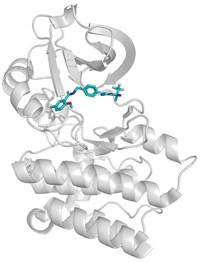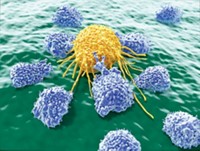Advertisement
Grab your lab coat. Let's get started
Welcome!
Welcome!
Create an account below to get 6 C&EN articles per month, receive newsletters and more - all free.
It seems this is your first time logging in online. Please enter the following information to continue.
As an ACS member you automatically get access to this site. All we need is few more details to create your reading experience.
Not you? Sign in with a different account.
Not you? Sign in with a different account.
ERROR 1
ERROR 1
ERROR 2
ERROR 2
ERROR 2
ERROR 2
ERROR 2
Password and Confirm password must match.
If you have an ACS member number, please enter it here so we can link this account to your membership. (optional)
ERROR 2
ACS values your privacy. By submitting your information, you are gaining access to C&EN and subscribing to our weekly newsletter. We use the information you provide to make your reading experience better, and we will never sell your data to third party members.
Pharmaceuticals
New Prostate Cancer Agent Class
Rational design leads to novel drug candidate, now in clinical trials
by Stu Borman
September 22, 2008
| A version of this story appeared in
Volume 86, Issue 38
BY FOCUSING on a key hormone receptor associated with prostate cancer, chemists have rationally designed a small molecule that provides the basis for a new treatment with a novel mechanism.
The agent was developed by synthetic and medicinal chemist Michael E. Jung of the University of California, Los Angeles, and coworkers, in collaboration with oncologist Charles L. Sawyers' group at Memorial Sloan-Kettering Cancer Center (MSKCC), in New York City. Jung discussed the project at last month's American Chemical Society national meeting in Philadelphia.
In his presentation, Jung explained that there are three types of prostate cancer. Nonmetastatic prostate cancer is typically not very aggressive and often remains untreated. "If a man is old enough, he will probably die of something else first," Jung said.
The second type, hormone-sensitive metastatic prostate cancer, is an aggressive cancer that responds to treatments that reduce male hormone levels—surgical castration and prescription of antiandrogen treatments such as Casodex and Anandron.
Surgical castration and antiandrogens "make the tumor growth go down, at least for a time," Jung said. "But after one to three years, about 60% of patients develop a third type of prostate cancer, which is also metastatic but can no longer be treated with antiandrogens." This type is called hormone-refractory, castration-refractory, or castration-resistant prostate cancer.
Jung and coworkers decided to pursue a medication against this third type of prostate cancer by targeting the androgen receptor. In a study of protein expression differences between hormone-sensitive and hormone-refractory prostate cancer cells, Sawyers and coworkers had found that the androgen receptor is upregulated by a factor of three to five in hormone-refractory cells, thus identifying it as a promising drug target.
The goal that Jung and coworkers set for themselves was to find small organic molecules that bind to the androgen receptor and that exhibit potent receptor blocking ability (antagonism), as well as little or no tendency to activate the receptor (agonism).
They decided to start with the compound RU59063 from the French company Roussel Uclaf. Even though the compound is an agonist of the androgen receptor, its ability to bind strongly to the receptor was an enticing trait. "The idea was to start with the agonist and see if there was any way to convert it to an antagonist," Jung said.
Using chemical synthesis and structure-based design, they developed a promising analog called RD37, which had good selectivity for the androgen receptor over other hormone receptors, acted as a receptor antagonist in hormone-refractory cells, and inhibited the growth of hormone-refractory tumors in mice. But its drug properties were poor: It was nonpolar and therefore was cleared from the body quickly.
"The idea was to start with the agonist and see if there was any way to convert it to an antagonist."
Additional synthetic and design efforts led to a new lead compound, RD162, which was more polar and therefore likely to stay in the body longer. Jung apologized to attendees at the Division of Carbohydrate Chemistry session at which he spoke because RU59063, RD37, and RD162 are not carbohydrates. "But that's OK," he argued, noting that "we're all trying to make drugs to stop disease" and that his talk highlighted just such an effort.
RD162 INDEED had much better drug properties than RD37 and yet retained potent androgen receptor antagonism in hormone-refractory cells. A trial in live mice with hormone-refractory prostate cancer showed that RD162 "knocked down the tumors," Jung said. "We were hitting hormone-refractory cells." The tests showed, surprisingly, that the agent was also effective against hormone-sensitive cells.
"This was pretty exciting," Jung said. "At this point, we got visited by all sorts of venture capitalists. Academics don't always get to meet rich folks who take you out and wine you and dine you. This was fun, and they kept mentioning numbers—really big numbers. I was ready to buy the Porsche. But eventually, they wanted either Charles Sawyers or me to run a new company, and we said no."
What the chemists did instead was to license their patents to Medivation, in San Francisco. "They didn't take RD162," Jung said. "They took another compound, an analog of RD162. I can't tell you what. I can't show it. But they called it MDV3100, and that is the compound they decided to move forward" into pharmacokinetics (absorption, distribution, metabolism, and excretion studies), toxicology, and animal tests.
Medivation's animal trials showed that MDV3100 reduced tumors to one-third or one-fourth of their original sizes. "We don't understand why" the drug acts as effectively as it does, Jung said. "The mechanism we have says it should be cytotoxic, but it instead appears to be apoptotic. All it's supposed to be doing is stop binding to the androgen receptor. But there's something else going on, and we're studying the system like crazy to find out."
Human trials of MDV3100 began in July 2007. "In October 2007, there was a Prostate Cancer Foundation meeting, and eight or 10 people I never met asked me for samples of MDV3100," Jung said. "Word was sneaking out that it was looking good. Medivation put out a press release in November, right after the meeting, saying that it was knocking down tumors, but only in six patients."
At the American Society of Clinical Oncology's annual meeting in Chicago, held in June of this year, the principal investigator of the clinical trial, genitourinary oncologist Howard I. Scher of MSKCC, said that in an ongoing 90-patient Phase I and II clinical trial of MDV3100, the compound "has been well tolerated, and early results suggest encouraging antitumor activity." If results continue to be positive, Medivation says it will seek Food & Drug Administration approval for a Phase III trial.
Taxotere and Novantrone are already approved medications for treatment of hormone-refractory prostate cancer, but they are not androgen-receptor antagonists. "They have marginal benefit, significant toxicity, and work by killing cells nonspecifically," Sawyers tells C&EN. "MDV3100 is novel because it has minimal side effects" and, Sawyer continues, it is targeted at the condition that specifically drives hormone-refractory metastatic prostate cancer—increased levels of androgen receptor.
In addition to MDV3100, an androgen receptor blocker called BMS-641988 is in clinical trials for hormone-refractory metastatic prostate cancer. BMS-641988 was developed by a group led by Mark E. Salvati, associate director of discovery oncology chemistry at Bristol-Myers Squibb, in Princeton, N.J. (C&EN, April 28, page 44). Like Jung and coworkers, the BMS group used structure-based drug design and medicinal chemistry to create their drug candidate. BMS-641988 is currently in a Phase I trial.
Jung noted that funding for his group's research on prostate cancer drug candidates "didn't come from the National Institutes of Health but from the Prostate Cancer Foundation founded by Michael Milken. Milken was treated for prostate cancer and has since remained cancer-free. He decided to raise money for prostate cancer research. Without him, we wouldn't have had the money for this project, so Michael Milken is to be thanked for this."






Join the conversation
Contact the reporter
Submit a Letter to the Editor for publication
Engage with us on Twitter